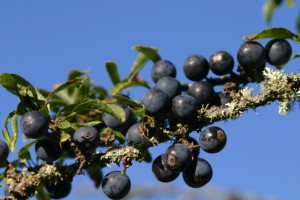 Last week’s post discussed the berries and fruits of the countryside that birds rely on such as redwings on rowan berries and blackbirds on hips. We also take advantage of the countryside’s harvest although our interest seems to have declined in recent years. I can recall seeing many people facing the thorns on bramble bushes and blackthorn after sloes. Admittedly there are a few select spots where people still collect brambles but nowhere near as many people as there used to be. I cannot recall when I last saw anyone collecting the sloes. Blackthorn bushes can be quite tall and rather impenetrable and I use to use a walking stick to either pull branches down or move some out of the way. I was always fascinated by the very dark blue berries covered, when young, with a paler bloom as shown in the photograph. The berries are best collected after the first frosts which make the berry softer and if you are making sloe gin it might just be ready for Christmas. Be very wary of the spines and you would do best to wear gloves as they are very sharp. A word of caution as you will need a lot of gin to make this recipe. Once you decant the sloe gin do not forget to eat the sloes that will have lost their bitter taste and will have soaked up some of the gin. I have also used the sloes to make sloe whisky and even sloe vodka!
Last week’s post discussed the berries and fruits of the countryside that birds rely on such as redwings on rowan berries and blackbirds on hips. We also take advantage of the countryside’s harvest although our interest seems to have declined in recent years. I can recall seeing many people facing the thorns on bramble bushes and blackthorn after sloes. Admittedly there are a few select spots where people still collect brambles but nowhere near as many people as there used to be. I cannot recall when I last saw anyone collecting the sloes. Blackthorn bushes can be quite tall and rather impenetrable and I use to use a walking stick to either pull branches down or move some out of the way. I was always fascinated by the very dark blue berries covered, when young, with a paler bloom as shown in the photograph. The berries are best collected after the first frosts which make the berry softer and if you are making sloe gin it might just be ready for Christmas. Be very wary of the spines and you would do best to wear gloves as they are very sharp. A word of caution as you will need a lot of gin to make this recipe. Once you decant the sloe gin do not forget to eat the sloes that will have lost their bitter taste and will have soaked up some of the gin. I have also used the sloes to make sloe whisky and even sloe vodka!
Rowan, sometimes called mountain ash, is a great favourite for “Food for Free” enthusiasts and the berries are best collected October before they go mushy. Unless the birds get them they will hang on the branches until January but are best collected much earlier. The classic use for the rowan berries is the jelly that is a delicious dark orange with a sharp marmalade flavour and is perfect with game, particularly venison, and lamb. Try adding a little chopped apple to provide the pectin.
The best book on the subject is still “Food for Free” written by Richards Mabey despite the fact that it was written and published as long ago as 1972. Various editions have come out since then but the outstanding one, and the one I refer to the most, is the one published in 2012 by HarperCollins. This is a large format hardback and is outstanding. In recent years a number of books have been published on the same subject but none compared with Richard Mabey’s. Brambles, sloes and rowan berry are only the tip of the iceberg with so many other foods readily available from mushrooms to seaweeds and beech nuts to shellfish.
After last week’s article one reader commented that I had not mentioned mammals taking berries and fruits. In this strath the presence of pine martens is often indicated by their droppings. At this time of the year the droppings may well be a bright orange red colour where the remains of rowan berry have been left behind. One reader recorded a pine marten clambering along a branch of a rowan so that it curved down and another pine marten on the ground was waiting for the berries to reach it. Wood mice often take rowan berries and they are so light they can walk out to the end of the branches. These mice will store the berries for the winter and they often put them in the cups of old birds’ nests to store for when the weather gets colder.
Tags: highland flora
